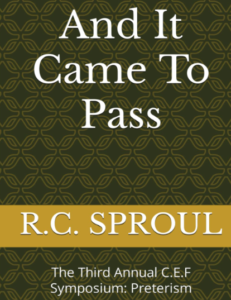
Author: Sproul, R.C.
Genre: Theology - Eschatology
Tags: Eschatology, Modern Authors / Theological Issues
Series:
Rick Shrader‘s Review:
This book is a composite of articles from The Third Annual C.E.F. Symposium on Preterism. It is fowarded by R.C. Sproul, the most well-known preterist of our day, and was published by Canon Plus in Moscow, Idaho in 1993. It is not, therefore, the most recent thing published by any means, but I don’t think much has changed since that year. Sproul writes, “The modern revival of preterism represents an interesting and important paradigm shift in eschatology.” It is interesting and somewhat important but I doubt much of the eschatological paradigm has shifted because of preterism. To describe it simply, preterism believes that most, if not all, prophecy was fulfilled in the first century, 70AD being the culmination of Armageddon and the return of Jesus Christ. A key verse for the preterist is Matthew 24:34, “This generation will by no means pass away till all these things are fulfilled.” This is taken to mean that all that is spoken of in Matthew 24-25 (the Olivet Discourse and therefore the whole tribulation period and glorious return of Christ) had to be fulfilled in the life-time of those original hearers. Therefore, the whole book of Revelation, they believe, was fulfilled in the first century as well. There are mild, moderate, and extreme forms of preterism, some believing that some of those things were fulfilled, some most, and some all. Preterism usually coincides with postmillennialism and dominion theology. That is, if the tribulation period was complete in 70AD, a spiritual form of the kingdom is now in progress. Douglas Wilson (writing two of the articles in this volume) for example believes we are now living in the new heaven and new earth and is actively changing laws and governments beginning in his home town of Moscow, Idaho (the “Redoubt” movement) where this volume was published.
Besides “this generation” of Matthew 24, the preterists believe there was no gap of time between Daniel’s 69th and 70th week and that all of the glorious events (including making an end of sin) of Daniel 9:24 were fulfilled at Christ’s first coming. The seven churches of Revelation 2-3 apply only to the seven churches that existed in the first century (though principles may still apply). The Antichrist has already come. He is either a heresy or might have been Nero. The Beast of Revelation is the first century Roman empire. Though speaking positively about historical-grammatical interpretation, the writers of this volume fill the pages with figures and allegorical pictures. In a section titled “Biblical Images” Christ Schlect, writing about the book of Revelation, says, “Did the sun turn black, and the moon red, and did the stars fall from the sky in 70 A.D.? Did a blasphemous beast rise from the sea and deceive all the elect at that time? Literalists use these examples as arguments against preterism and those who are unfamiliar with Old Testament prophecy may be tempted to listen” (p. 104). Within three page the reader finds the words, “images,” “word pictures,” “subtle allusions,” “symbols and images (2x),” “Old Testament imagery,” “a sign of judgment” (2x). And this in defense of literal hermeneutics. There are more recent books to read on preterism (R.C. Sproul’s The Last Days According to Jesus), but this volume gives an interesting assortment of their views.
